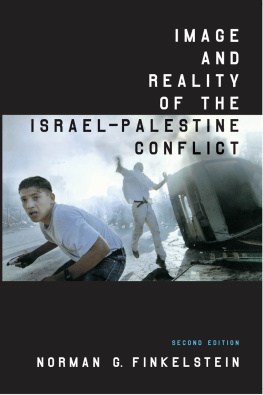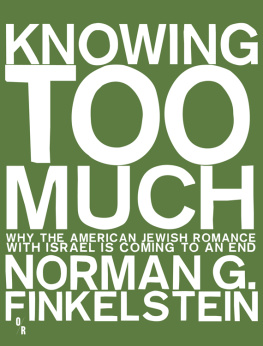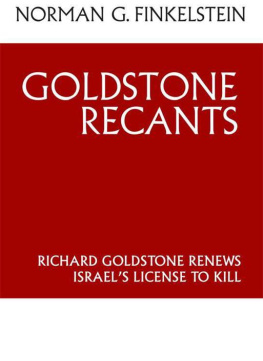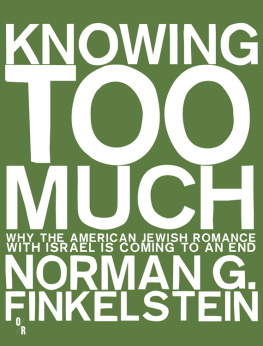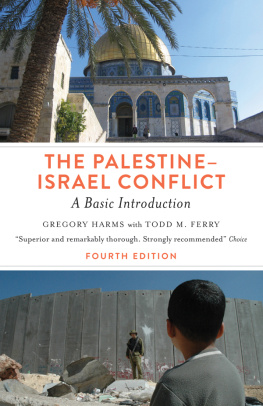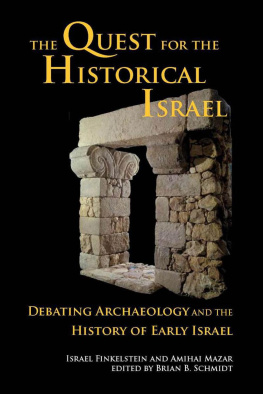Over the past decade I benefited from the generosity of many individuals; no words can adequately express my gratitude. Roane Carey, Allan Nairn and Cyrus Veeser expertly served as my personal editors. Carol Chomsky, Noam Chomsky and Samira Haj commented on all the chapters in draft form. Albeit in different ways, each also played a crucial role in ushering the book from conception to completion. I am equally grateful to Nabeel Abraham and Nawal Ragheb for being there all these years. Unless otherwise indicated, Hebrew-language periodicals are cited from Israel Shahaks invaluable Translations from the Hebrew Press. I want also to thank personally several individuals who gave unsparingly of themselves: Rudolph Baldeo, Harry Chomsky, Carolyn Fialkow, Joanne Koslofsky, Ellen Mastromonaco, Donald Neff, Adele Oltman, Richard Parker, William Quandt, Frank Sheed and Mariam Touba. I owe the books title as well as its overarching structure to Noam Chomsky. All errors of fact, reasoning and judgment are my own.
The conquest of the earth, which mostly means the taking it away from those who have a different complexion or slightly flatter noses than ourselves, is not a pretty thing when you look into it too much.
Introduction to the
Second Edition
The logical implication of trying to create a continent neatly divided into coherent territorial states, each inhabited by a separate ethnically and linguistically homogeneous population, was the mass expulsion or extermination of minorities. Such was and is the murderous reductio ad absurdum of nationalism in its territorial version, although this was not fully demonstrated until the 1940s. The homogeneous territorial nation could now be seen as a programme that could be realized only by barbarians, or at least by barbarian means.
E.J. Hobsbawm, Nations and Nationalism since 1780
Background
To resolve what was called the Jewish question i.e., the reciprocal challenges of Gentile repulsion, or anti-Semitism, and Gentile attraction, or assimilation the Zionist movement sought in the late nineteenth century to create an overwhelmingly, if not homogeneously, Jewish state in Palestine.
Across the mainstream Zionist spectrum, it was understood from the outset that Palestines indigenous Arab population would not acquiesce in its dispossession. Contrary to the claim that is often made, Zionism was not blind to the presence of Arabs in Palestine, Zeev Sternhell observes. If Zionist intellectuals and leaders ignored the Arab dilemma, it was
The tragedy of Zionism, Walter Laqueur wrote in his standard history, was that it appeared on the international scene when there were no longer empty spaces on the world map. This is not quite right. Rather it was no longer politically tenable to create such spaces: extermination had ceased to be an option of conquest.
Round One The Way of Transfer
In the first round of conquest, the Zionist movement set its sights on the way of transfer. For all the public rhetoric about wanting to live with the Arabs in conditions of unity and mutual honor and together with them to turn the common homeland into a flourishing land (Twelfth Zionist Congress, 1921), the Zionists from early on were in fact bent on expelling them. The idea of transfer had accompanied the Zionist movement from its very beginnings, Tom Segev reports. Disappearing the Arabs lay at the heart of the Zionist dream, and was also a necessary condition of its existence. With few exceptions, none of the Zionists disputed the desirability of forced transfer or its morality. The key was to get the timing right. Ben-Gurion, reflecting on the expulsion option in the late 1930s, wrote: What is inconceivable in normal times is possible in revolutionary times; and if at this time the opportunity is missed and what is possible in such great hours is not carried out a whole world is lost.
The goal of disappearing the indigenous Arab population points to a virtual truism buried beneath a mountain of apologetic Zionist literature: It ought also to be remembered that Zionist leaders consistently claimed to be acting on behalf and with the support of world Jewry, a claim which to many Palestinians seemed increasingly credible, as first non-Zionist Jews in Palestine were marginalized during the Mandate as noted above and, especially after 1967, as non-Zionist Jews around the world became, if not a small minority, certainly an increasingly voiceless one.
From its incipient stirrings in the late nineteenth century through the watershed revolt in the 1930s, Palestinian resistance consistently focused on the twin juggernauts of Zionist conquest: Jewish settlers and Jewish settlements.
It bears critical notice for what comes later that, from the interwar through early postwar years, Western public opinion was not altogether averse to population transfer as an expedient (albeit extreme) method for resolving ethnic conflicts. French socialists and Europes Jewish press supported in the mid-1930s the transfer of Jews to Madagascar to solve Polands Jewish problem.
In fact, many in the enlightened West came to view displacement of the indigenous population of Palestine as an inexorable concomitant of civilizations advance. The identification of Americans with Zionism came easily, since the social order of the Yishuv [Jewish community in Palestine] was built on the ethos of a frontier society, in which a pioneering-settlement model set the tone. To account for the almost complete disregard of the Arab case by Americans, a prominent British Labour MP, Richard Crossman, explained in the mid-1940s: Zionism after all is merely the attempt by the European Jew to build his national life on the
Come 1948, the Zionist movement exploited the revolutionary times of the first ArabIsraeli war much like the Serbs did in Kosovo during the NATO attack to expel more than 80 per cent of the indigenous population (750,000 Palestinians), and thereby achieve its goal of an overwhelmingly Jewish state, if not yet in the whole of Palestine.

